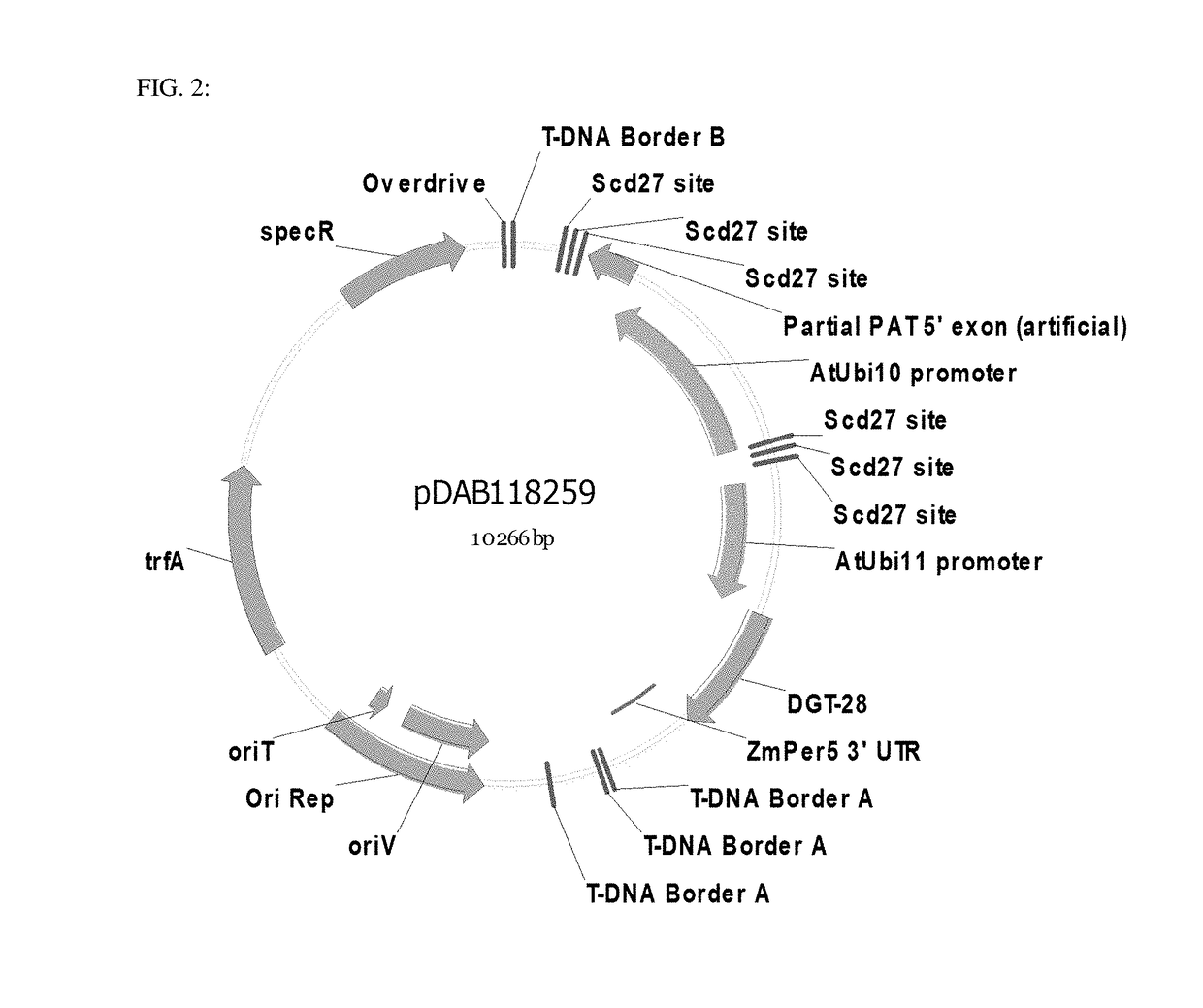Site specific integration of a transgne using intra-genomic recombination via a non-homologous end joining repair pathway
a transgne and non-homologous technology, applied in recombinant dna-technology, biochemistry apparatus and processes, genetic engineering, etc., can solve the problems of inefficient transformation of transgenes within undesirable locations of plant genomes, low transformation efficiency, and limited application of methods
- Summary
- Abstract
- Description
- Claims
- Application Information
AI Technical Summary
Benefits of technology
Problems solved by technology
Method used
Image
Examples
embodiments
[0093]The subject disclosure relates to a method for inserting a donor DNA within a plant genomic target locus. In embodiments, the donor DNA is initially integrated within the plant genome and is then mobilized into a specific plant genomic target locus. In some embodiments, a first viable plant containing a genomic DNA is provided that contains a donor DNA flanked by a plurality of recognition sequences and the plant genomic target locus, wherein the plant genomic target locus also contains at least one recognition sequence. In some embodiments, a second viable plant containing a site specific nuclease is provided. In some embodiments, the first and second viable plants are crossed to produce F1 seed. In some embodiments, the site specific nuclease is expressed and cleaves at least one site specific nuclease recognition sequence to release a donor polynucleotide and to create a double strand break within the plant genomic locus. In some embodiments, the donor DNA is integrated wit...
example 1
d Construction of Tobacco Gene Expression Cassettes
[0174]The pDAB1585 (FIG. 1) binary plasmid was constructed. This plasmid vector contained several gene expression cassettes and site specific nuclease recognition sequences for targeting of donor polynucleotide sequences. The first gene expression cassette contained the Arabidopsis thaliana Ubiquitin 3 promoter (At Ubi3 promoter) operably linked to the hygromycin resistance gene (HPTII), and was terminated by the Agrobacterium tumefaciens ORF24 3′ UTR termination sequence (Atu ORF 24 3′ UTR). This gene expression cassette was followed by a RB7 matrix attachment region (RB7 MAR), and the Scd27 site specific nuclease recognition sequence (Scd27 ZFP site). Four tandem repeats of recognition sequences (i.e. Scd27 ZFN binding sites) flanked the MAR and 4-CoAS intron sequences. The binding sites were palindromic sequences (SEQ ID NO:28; GCTCAAGAACAT and SEQ ID NO:29; TACAAGAACTCG), such that only a single ZFN needed to be expressed for th...
example 2
Zinc Finger Proteins
[0178]Zinc finger proteins directed against the identified DNA recognition sequences of SCD27 and IL-1 were designed as previously described. See, e.g., Urnov et al., (2005) Nature 435:646-551. Exemplary target sequence and recognition helices and recognition sequences were originally provided in U.S. Pat. No. 9,428,756 and U.S. Pat. No. 9,187,758 (the disclosure of which are herein incorporated by reference in their entirety). Zinc Finger Nuclease (ZFN) recognition sequences were designed for the previously described recognition sequences. Numerous ZFP designs were developed and tested to identify the fingers which bound with the highest level of efficiency with the recognition sequences of the recognitions sequences. The specific ZFP recognition helices which bound with the highest level of efficiency to the zinc finger recognition sequences were used for targeting and integration of a donor sequence within the Zea mays genome.
[0179]The Scd27 and IL-1 zinc fing...
PUM
| Property | Measurement | Unit |
|---|---|---|
| RH | aaaaa | aaaaa |
| insecticidal resistance | aaaaa | aaaaa |
| nucleic acid sequences | aaaaa | aaaaa |
Abstract
Description
Claims
Application Information
 Login to View More
Login to View More - R&D
- Intellectual Property
- Life Sciences
- Materials
- Tech Scout
- Unparalleled Data Quality
- Higher Quality Content
- 60% Fewer Hallucinations
Browse by: Latest US Patents, China's latest patents, Technical Efficacy Thesaurus, Application Domain, Technology Topic, Popular Technical Reports.
© 2025 PatSnap. All rights reserved.Legal|Privacy policy|Modern Slavery Act Transparency Statement|Sitemap|About US| Contact US: help@patsnap.com



